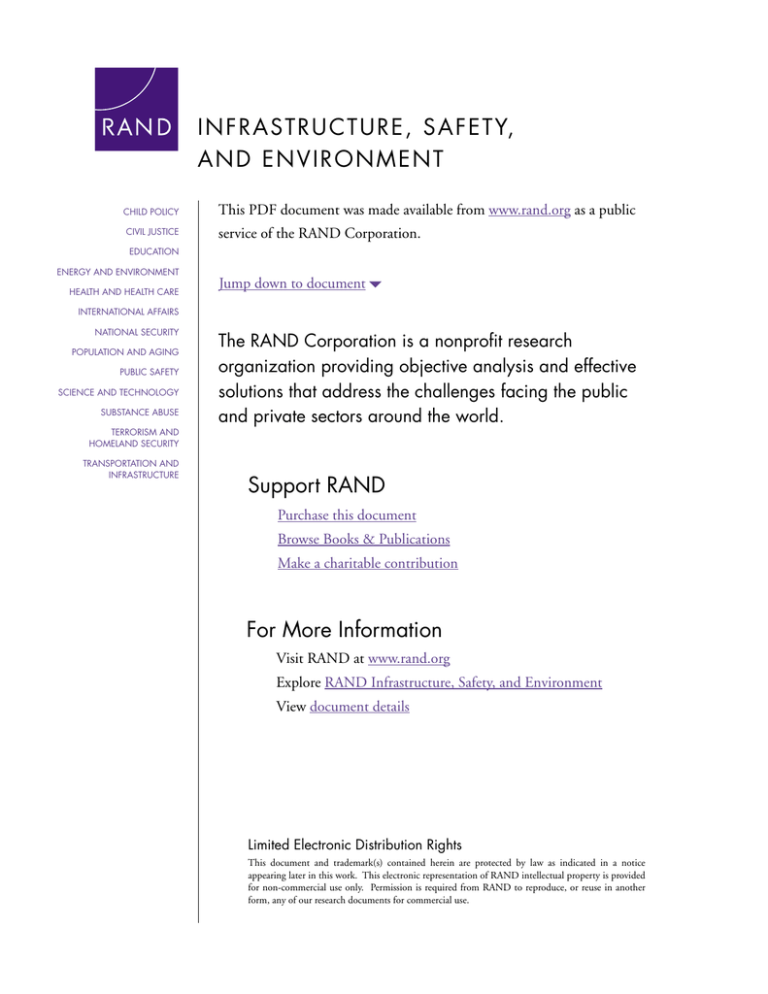
I N F RA S TR U CTUR E, SAF ETY,
A N D EN V IR ONMENT
CHILD POLICY
CIVIL JUSTICE
This PDF document was made available from www.rand.org as a public
service of the RAND Corporation.
EDUCATION
ENERGY AND ENVIRONMENT
HEALTH AND HEALTH CARE
Jump down to document6
INTERNATIONAL AFFAIRS
NATIONAL SECURITY
POPULATION AND AGING
PUBLIC SAFETY
SCIENCE AND TECHNOLOGY
SUBSTANCE ABUSE
TERRORISM AND
HOMELAND SECURITY
TRANSPORTATION AND
INFRASTRUCTURE
The RAND Corporation is a nonprofit research
organization providing objective analysis and effective
solutions that address the challenges facing the public
and private sectors around the world.
Support RAND
Purchase this document
Browse Books & Publications
Make a charitable contribution
For More Information
Visit RAND at www.rand.org
Explore RAND Infrastructure, Safety, and Environment
View document details
Limited Electronic Distribution Rights
This document and trademark(s) contained herein are protected by law as indicated in a notice
appearing later in this work. This electronic representation of RAND intellectual property is provided
for non-commercial use only. Permission is required from RAND to reproduce, or reuse in another
form, any of our research documents for commercial use.
This product is part of the RAND Corporation technical report series. Reports may
include research findings on a specific topic that is limited in scope; present discussions of the methodology employed in research; provide literature reviews, survey
instruments, modeling exercises, guidelines for practitioners and research professionals, and supporting documentation; or deliver preliminary findings. All RAND
reports undergo rigorous peer review to ensure that they meet high standards for research quality and objectivity.
The Impact of Extended
Vehicle Emission
Warranties on California’s
Independent Repair Shops
Lloyd Dixon
Prepared for the California Air Resources Board
The research described in this report was sponsored by the California Air Resources Board
through Agreements 00-604 and 03-612 and was conducted within RAND Infrastructure,
Safety, and Environment (ISE), a unit of the RAND Corporation
Library of Congress Cataloging-in-Publication Data
Dixon, Lloyd S.
The impact of extended vehicle emission warranties on California’s independent repair shops / Lloyd Dixon.
p. cm.
“TR-235.”
Includes bibliographical references.
ISBN 0-8330-3750-1 (pbk. : alk. paper)
1. Service stations—California. 2. Environmental law—Compliance costs—California. 3. Warranty. 4. Air—
Pollution—California—Prevention—Costs. I.Title.
TL153.D548 2005
629.28'6—dc22
2005003657
The RAND Corporation is a nonprofit research organization providing objective analysis
and effective solutions that address the challenges facing the public and private sectors
around the world. RAND’s publications do not necessarily reflect the opinions of its research
clients and sponsors.
R® is a registered trademark.
© Copyright 2005 RAND Corporation
All rights reserved. No part of this book may be reproduced in any form by any electronic or
mechanical means (including photocopying, recording, or information storage and retrieval)
without permission in writing from RAND.
Published 2005 by the RAND Corporation
1776 Main Street, P.O. Box 2138, Santa Monica, CA 90407-2138
1200 South Hayes Street, Arlington, VA 22202-5050
201 North Craig Street, Suite 202, Pittsburgh, PA 15213-1516
RAND URL: http://www.rand.org/
To order RAND documents or to obtain additional information, contact
Distribution Services: Telephone: (310) 451-7002;
Fax: (310) 451-6915; Email: order@rand.org
Summary
The California Air Resources Board (CARB) allows automobile manufacturers to satisfy
part of the state’s Zero Emission Vehicle (ZEV) Program requirements by manufacturing and
selling partial-zero emission vehicles (PZEVs). When new, PZEVs must meet very stringent
emission standards, and in an effort to keep emissions low as the vehicles age, CARB requires
that they be covered by a comprehensive 15-year/150,000-mile emissions-system warranty.
The PZEV warranty extends the three-year/50,000-mile emissions warranty currently
required in California. To be covered under warranty, repairs must usually be done at dealer
repair shops and, thus, CARB has expressed concern that extended warranties may adversely
affect independent repair shops.
This report examines and quantifies, where possible, the effects of extended vehicle
warranties on the independent repair industry. The findings are based on a survey of the
vehicle-repair behavior of drivers in 366 households across California, a survey of repairs at 48
independent repair shops and 28 dealer repair shops in California, existing data on the vehicle
repair and maintenance industry, and models of the vehicle fleet that were developed by CARB.
Effects of Extended Warranties on Independent Repair Shop Revenue
A model of consumer expenditures at independent and dealer repair shops was used to
estimate the impact of extended emission warranties on revenues at independent repair
shops. Estimates were based on scenarios for the number of PZEVs produced between 2003
and 2020.1 In the scenario in which manufacturers produce the maximum number of PZEVs
that can be used to satisfy ZEV program requirements (the “maximum-PZEV” scenario), the
1The ZEV program took effect in the 2005 model year, although manufacturers produced PZEVs in 2003 and 2004 to
generate credits that can be used to satisfy ZEV program requirements.
xi
xii
The Impact of Extended Vehicle Emission Warranties on California’s Independent Repair Shops
number of PZEVs on the road increases gradually starting in 2003 and reaches 38 percent of
the light-duty vehicles (LDVs) in California by 2020.
Independent Repair Shop Revenue in California Will Continue to Grow with Extended
Warranties but at a Slower Rate
Figures S.1 through S.4 present the predictions for the maximum-PZEV scenario in constant
year-2004 dollars. Extended warranties have no effect on independent repair shop revenue
in California between 2003 and 2005 because warranties for the first three years or 50,000
miles of a PZEV’s life remain the same as those on vehicles with standard emission warranties.
Using a base-case set of parameter values, revenue at independent repair shops is predicted to
be 0.8 percent lower ($120 million of $15.4 billion) in the maximum-PZEV scenario than it
otherwise would be in 2010 and 4.1 percent lower ($730 million of $17.9 billion) in 2020.2
There is considerable uncertainty in many of the parameters that underlie the
predictions. This analysis, thus, examines how the results change when the parameters
are allowed to vary over their likely ranges. The result is that the predicted decline in
independent repair shop revenue in 2020 ranges from 2.2 to 6.9 percent ($375 million
to $1.3 billion) in the maximum-PZEV scenario (as shown by the 90-percent probability
intervals in Figures S.1 and S.2).3
Figure S.1
Percentage Difference in Annual Revenue at Independent Repair Shops Due to
Extended Warranties, 2003–2002, Maximum-PZEV Scenario
0.0
Percentage difference in annual revenue
–1.0
–2.0
–3.0
–4.0
–5.0
90% probability interval
Base case
–6.0
–7.0
2020
2019
2018
2017
2016
2015
2014
2013
2012
2011
2010
2009
2008
2007
2006
2005
2004
2003
–8.0
RAND TR235-S.1
2 Estimates of independent repair shop revenue do not include revenue from collision repairs and vehicle customization.
Including these types of service would increase the baseline for independent repair shop revenue and thus reduce the
percentage decline in revenue somewhat from that predicted here.
3
The 90-percent probability interval is determined by the uncertainty in the parameters that underlie the prediction.
There is a 90-percent chance that the effect of extended emissions warranties will fall in the interval, given the assumptions
on the distributions of the underlying parameters.
Summary
xiii
Figure S.2
Dollar Difference in Revenue at Independent Repair Shops Due to Extended Warranties, 2003–2020,
Maximum-PZEV Scenario
Difference in annual revenue ($millions)
0
–200
–400
–600
–800
90% probability interval
Base case
–1,000
–1,200
2020
2019
2018
2017
2016
2015
2014
2013
2012
2011
2010
2009
2008
2007
2006
2005
2004
2003
–1,400
RAND TR235-S.2
Even though revenue at independent repair shops will be lower with extended warranties
than it would be if warranties were not extended, revenue at independent repair shops in
California will grow between 2003 and 2020 even with extended warranties (see Figure S.3).
Projected revenue climbs 30 percent between 2003 and 2020 in the maximum-PZEV scenario
with extended warranties and 36 percent without them. This increase is driven by a projected
32-percent rise in the number of vehicles on the road between 2003 and 2020 and a gradual
increase in average vehicle age over this period. Figure S.4 shows the change over time in
independent repair shop revenue with extended warranties from the level of revenues in 2003.
While it seems plausible that manufacturers will produce enough PZEVs to just
satisfy as much of the ZEV program as program rules allow, the number they will actually
produce is uncertain. Manufacturers could conceivably produce fewer PZEVs than in the
maximum-PZEV scenario, or competitive pressures could induce them to produce more
than in the maximum-PZEV scenario. The effects of extended warranties were thus simulated
under various scenarios for the number of PZEVs produced. The effects were found to be
roughly proportional to the number of PZEVs produced. Even when it was assumed that
all vehicles sold after 2008 carried extended warranties, revenue at independent repair shops
grew 25 percent between 2003 and 2020. The growth in independent repair shop revenue
would not be as large if the vehicle fleet grows more slowly than expected.
While there is some evidence that the durability of emission-control systems has
improved in recent years, sufficient data were not available to project future improvements.
Thus, the effects of extended emission warranties are predicted assuming no change in
durability. Durability may improve, however, and the simulations in this report show that
xiv
The Impact of Extended Vehicle Emission Warranties on California’s Independent Repair Shops
Figure S.3
Annual Revenue at Independent Repair Shops with Extended Emission Warranties, 2003–2020,
Maximum-PZEV Scenario
20.0
Annual revenue ($billions)
18.0
16.0
14.0
12.0
10.0
90% probability interval
Base case
8.0
2020
2019
2018
2017
2016
2015
2014
2013
2012
2011
2010
2009
2008
2007
2006
2005
2004
2003
6.0
RAND TR235-S.3
Figure S.4
Change in Annual Revenue at Independent Repair Shops from 2003 with Extended Warranties, 2003–
2020, Maximum-PZEV Scenario
Change in annual revenue from 2003 ($millions)
5,000
4,500
90% probability interval
Base case
4,000
3,500
3,000
2,500
2,000
1,500
1,000
500
RAND TR235-S.4
2020
2019
2018
2017
2016
2015
2014
2013
2012
2011
2010
2009
2008
2007
2006
2005
2004
2003
0
Summary
xv
estimates assuming no change in durability will likely overstate changes in independent repair
shop revenue when durability improvements are factored in.
More specifically, there are two types of durability improvements of interest. First,
durability may improve even if warranties are not extended due to the phase-in of more
stringent vehicle certification requirements and more extensive emissions testing of
vehicles in use. Such an improvement would reduce the impact of extended warranties on
independent repair shops because there would be fewer repairs that could migrate from
independents to dealers. This type of durability improvement would thus cause the estimates
in this report to overstate the actual effect of extended emission warranties on independent
repair shops. Second, extended emission warranties might also improve durability. Such an
improvement could, on the one hand, magnify the adverse effects of extended warranties
on independent repair shops because, in addition to reducing the share of work that goes to
independents, extended warranties would reduce the overall amount of work to be split. On
the other hand, durability improvements caused by extended emission-system warranties
could cause fewer non-emission-system repairs to migrate from independents to dealers (so
called pull-along work) when warranties are extended.
Based on estimates of the amount of non-emission work that is done along with
emission work, the simulations show that improvements in durability due to extended
emission warranties will likely reduce the negative impact of extended emission warranties on
independent repair shops. Thus, the predictions here (which assume no change in durability)
will again tend to overstate the effects of extended emission warranties.
Effects on Shop Workers, Owners, and Consumers
By reducing revenue at independent repair shops from what it would be otherwise, extended
warranties may adversely affect workers at independent repair shops, independent repair shop
owners, and consumers.
Extended Warranties Should Not Cause Layoffs in the Repair Industry as a Whole,
Although There May Be Layoffs at Some Independent Repair Shops
Aggregate revenue at independent repair shops is predicted to grow even with extended
warranties. Thus, there should be no need to lay off current workers at independent repair shops
as a whole. However, the findings of this study suggest that some independent repair shops will
likely be more affected by extended emission warranties than others. Extended warranties may,
thus, cause layoffs at some independent repair shops even though employment at all independent
shops combined grows. These layoffs may cause hardship for some workers. Whether or how
many independent repair shops might have to lay off employees could not be quantified;
however, because the impacts of extended warranties are felt only gradually over time, workforce
reductions could possibly be handled through normal attrition. In addition, workers may be able
to quickly find employment at other independent repair shops or at dealer repair shops.
Extended Warranties Will Likely Reduce Profits of Independent Repair Shop
Owners Somewhat
In the standard competitive economic model, increases in demand raise prices, which in turn
increase profits of the firms currently in business above the normal return on capital. In the
xvi
The Impact of Extended Vehicle Emission Warranties on California’s Independent Repair Shops
case of the repair industry, these extra-normal profits would encourage new independent
repair shops to enter the market, reducing prices and profits per firm. Extended emission
warranties will cause demand for services at independent repair shops to increase more slowly
than it would without extended warranties. This implies that existing independent repair
shops will enjoy fewer periods of extra-normal profits than they would otherwise. The loss to
current owners is the discounted present value of these foregone profits.
Several factors will moderate the significance of these losses. First, compared with many
other industries, it seems easy for new firms to enter the vehicle-repair industry. Easy entry
will limit the amount of extra-normal profits. Second, many of the losses will be felt ten or
more years in the future. The relatively high discount rate appropriate for small-business
profits and the long lead times for the effects of extended warranties will substantially reduce
the present value of the losses. Finally, as reported above, independent repair shop revenue is
expected to grow 30 percent over 18 years with extended warranties and 36 percent without
them. It seems unlikely that the present value of the lost profits will be large relative to the
size of discounted profits over this period.
There Will Likely Continue to Be a Large Number of Independent Repair Shops in
Most Parts of the State
Slower revenue growth at independent shops may mean fewer independent repair shops
than there would be otherwise. Fewer repair shops may mean that repair shops are less
conveniently located for some consumers. It may also mean less competition and possibly
higher prices at both dealer and independent repair shops.
Investigation of how slower growth in revenue may translate into slower growth in
the number of repair shops (or may translate into more rapid decline in the number of
independent repair shops if other factors are causing consolidation in the industry) was
beyond the scope of this analysis. Revenue growth between 2003 and 2020 is predicted to be
6.0 percentage points slower with extended warranties, so the effect on the number of repair
shops is not likely to be great, and a large number of independent repair shops will still likely
be in the state.
The reduction in the number of repair shops per vehicle could have more significant
consequences for consumers in some parts of the state than in others. For example, the
effects could be greater in sparsely populated rural areas where there are few dealer or
independent repair shops to start with. This analysis did not allow a determination of
whether or how effects on the number of repair shops will vary by region or how the effects
on consumers of any declines in the number of shops that did occur will differ between
urban and rural areas.
It should be noted, though, that added business at dealer repair shops may induce
dealers to open up more locations, which would offset some of the decline in the number
of independent repair shops. A full analysis of the effect of extended emissions warranties
on drivers and Californians more generally would also need to consider benefits in
dimensions not examined here including cleaner air and more durable vehicle emission
control systems.
Summary
xvii
Policy Implications
The study results suggest that the effect of extended emission warranties on independent
repair shops will not be large and will be felt only gradually over time. The California Air
Resources Board may still want to consider programs to reduce the impacts that do exist.
Options are examined in Chapter Eight for preventing or reducing the effects that occur in
the first place, reducing the negative ramifications of effects that do occur, and compensating
repair shop owners for their losses.
Policies that facilitate the transition of workers at independent repair shops to new
jobs could be an attractive way to reduce negative ramifications that do occur. Requiring
automakers to cover emission repairs using service contracts that allow repairs to be done
at an approved network of independent repair shops is a potentially promising option
for reducing the declines in business at independent repairs shops. Consumer education
on emission warranties also is a potentially promising option for reducing the effects on
independent repair shops. Better information on warranties may reduce the frequency with
which drivers go to a dealer for repairs that are not covered under warranty because such
information will clarify what the warranty does and does not cover, and better information
may also dispel any notions that maintenance work must be done at the dealer to maintain
the warranty. While the effects of emission-system warranties predicted by this analysis
suggest that the benefits of such interventions will not be great, it is up to policymakers to
determine whether further exploration of these options is warranted.






